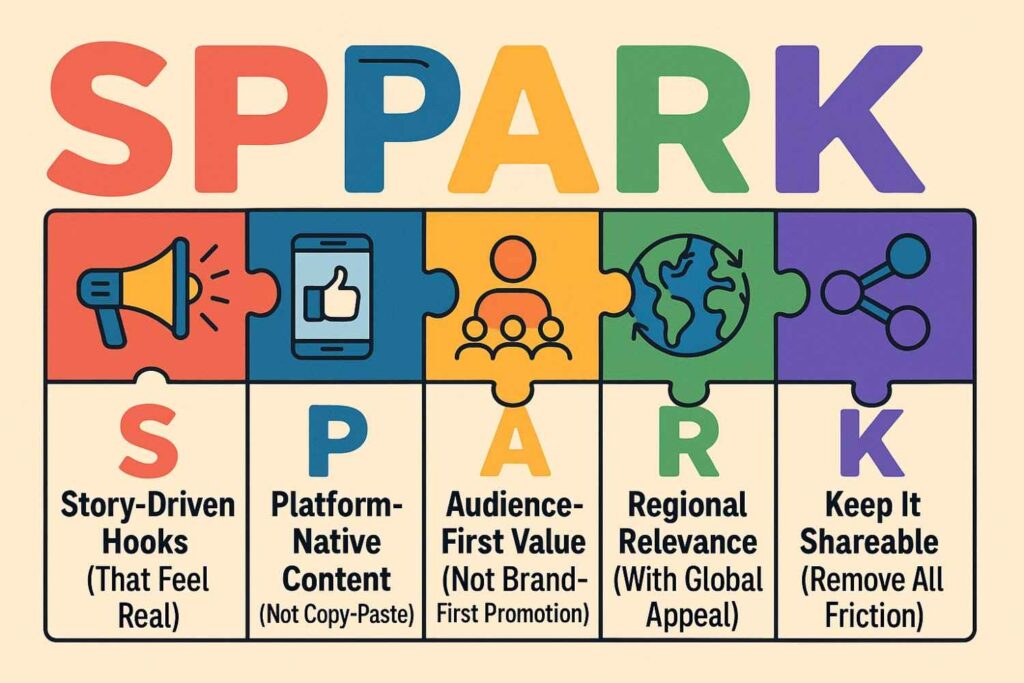Table Of Content
- Why I’m Writing This (And Why It Matters to You)
- The Viral Marketing Reality Check
- What I’ve Learned Building ClassyStreet
- The SPARK Framework That Actually Works
- S – Story-Driven Hooks (That Feel Real)
- P – Platform-Native Content (Not Copy-Paste)
- A – Audience-First Value (Not Brand-First Promotion)
- R – Regional Relevance (With Global Appeal)
- K – Keep It Shareable (Remove All Friction)
- Real Stories, Real Results
- Case Study 1: The Regional Language Experiment
- Case Study 2: The Cultural Bridge
- Case Study 3: The Problem-Solution Pivot
- The Measurement That Matters
- Your Next Steps (Starting Today)
Why I’m Writing This (And Why It Matters to You)
Let me be brutally honest with you.
After 11+ years in India’s e-commerce trenches—from building ClassyStreet to mentoring hundreds of founders through NITI Aayog—I’ve seen too many brilliant entrepreneurs get caught up in the viral marketing hype without understanding what actually works.
You know what I’m talking about. You’ve probably been there too.
You see a Zomato meme get 50,000 shares, or watch Boat’s latest campaign explode across Instagram, and think, “If only my content could go viral like that, my store would be set.” You try to replicate their success, but your content gets 12 likes and crickets.
Here’s the uncomfortable truth: Viral marketing isn’t about copying what worked for someone else. It’s about understanding your audience so deeply that you create content they can’t help but share.
And this understanding looks very different whether you’re selling to a tech executive in Bangalore, a small business owner in Bhopal, or a college student in Brooklyn.
The Viral Marketing Reality Check
Before we dive deep, let’s address the elephant in the room.
In India, we often get caught between two extremes: either blindly copying Western marketing tactics that don’t resonate with our diverse audience, or sticking to traditional approaches that don’t leverage digital platforms effectively.
The real opportunity lies in the middle ground.
I’ve seen handloom sellers from Kanpur create more engaging content than million-dollar brands, simply because they understood their audience’s emotions, language, and cultural context. I’ve also watched Silicon Valley startups crash and burn in the Indian market because they couldn’t adapt their “viral” content to local sensibilities.
Here’s what 11 years in this ecosystem has taught me:
For Indian Markets:
- Emotional storytelling around family, tradition, and aspiration drives shares more than pure entertainment
- Regional language content often outperforms English, even among English-speaking audiences
- Festival and cultural moment marketing isn’t optional—it’s essential
- Price-value narratives resonate differently across Tier 1, 2, and 3 cities
For Global Markets:
- Authenticity beats polish every time
- Problem-solution narratives work universally
- Visual content transcends language barriers
- Community-building creates sustainable viral momentum
The Sweet Spot: Create content that honors local context while leveraging universal human emotions. This is where the magic happens.
What I’ve Learned Building ClassyStreet
Running ClassyStreet taught me something most e-commerce courses won’t tell you: Your best viral content often comes from your biggest challenges.
When we started, explaining handloom products to urban customers was our biggest hurdle. Instead of hiding this challenge, we made it our content strategy. We created videos showing:
- The 72-hour process behind a single handwoven saree
- Artisans explaining their craft in their own words (with subtitles)
- The contrast between mass-produced and handmade quality
Result? Our “Meet the Weaver” series got more shares than any polished product shoot we ever created. Why? Because it told a story people felt good about sharing—it made them look culturally aware, socially conscious, and informed.
Key Insight: Your unique challenges are often your biggest content opportunities. Don’t hide them; highlight them.
The SPARK Framework That Actually Works

After analyzing successful campaigns from Boat to Byju’s, Glossier to Grofers, I’ve developed this framework that works across cultures and markets:
S – Story-Driven Hooks (That Feel Real)
Forget “Our Blades Are F***ing Great.” That works in some markets, not others.
For Indian Audiences: Start with relatable problems. Zomato’s “Delivery in 30 minutes? More like 30 missed calls from hungry friends” resonates because every Indian has lived this experience.
For Global Audiences: Lead with universal truths. Glossier’s “Skin first, makeup second” works because it addresses a global shift in beauty standards.
The Universal Formula: Shared Experience + Unexpected Insight + Emotional Connection
Example from ClassyStreet: Instead of “Buy handloom products,” we led with “Why your grandmother’s saree looks better than anything in your wardrobe (and what that teaches us about real quality).”
P – Platform-Native Content (Not Copy-Paste)
Here’s where most brands mess up. They create one piece of content and blast it across all platforms.
What Actually Works:
Instagram (Indian Context):
- Stories with polls in Hindi/regional languages
- Reels featuring behind-the-scenes content with popular audio tracks
- User-generated content with cultural context
Instagram (Global Context):
- High-quality visuals with minimalist aesthetics
- Stories with interactive stickers and polls
- Influencer collaborations with authentic product integration
LinkedIn (Indian Context):
- Success stories of small business partnerships
- Industry insights with local business angles
- Personal founder journey posts
LinkedIn (Global Context):
- Data-driven industry insights
- Thought leadership on business trends
- Professional development content
The Key: Adapt your core message to each platform’s native format and audience expectations.
A – Audience-First Value (Not Brand-First Promotion)
This is where most e-commerce brands get it wrong. They create content to promote products. Viral content promotes value first, products second.
Indian Market Examples:
Boat doesn’t just showcase earphones; they create content around music culture, cricket moments, and youth lifestyle that happens to feature their products.
Nykaa doesn’t just sell cosmetics; they educate about skincare routines, festival makeup looks, and confidence-building that naturally incorporates their products.
Global Market Examples:
Patagonia creates content about environmental conservation that aligns with their brand values while subtly showcasing their products.
Warby Parker focuses on eye health awareness and style education rather than direct product promotion.
Your Action Plan:
- List your audience’s top 5 daily challenges
- Create content that solves these challenges
- Naturally integrate your products as solutions
- Make the value so good that sharing feels like helping friends
R – Regional Relevance (With Global Appeal)
Here’s something I learned the hard way: content that works in Mumbai might flop in Madurai, and what goes viral in New York might be invisible in New Delhi.
The Three-Layer Strategy:
Layer 1: Universal Human Emotions Love, fear, joy, surprise, pride—these work everywhere. Build your content foundation on these.
Layer 2: Cultural Context Adapt the expression of these emotions to local contexts:
- Indian festivals and celebrations
- Regional languages and dialects
- Local trends and memes
- Cultural values and traditions
Layer 3: Platform Optimization Tailor the format and delivery to platform norms in each market.
Real Example: Our Diwali campaign for ClassyStreet worked because:
- Universal emotion: Pride in heritage and tradition
- Cultural context: Diwali shopping and gifting culture
- Platform optimization: Instagram stories in regional languages, WhatsApp-friendly formats for easy family sharing
K – Keep It Shareable (Remove All Friction)
The best content in the world won’t go viral if sharing is difficult.
Technical Shareability:
- Mobile-optimized formats (90% of sharing happens on mobile)
- Quick loading times (3-second rule)
- Clear, readable text on all screen sizes
- Easy-to-find share buttons
Cultural Shareability (India-Specific):
- WhatsApp-friendly formats and sizes
- Content that works with family groups (appropriate for all ages)
- Regional language options
- Festival and cultural moment tie-ins
Cultural Shareability (Global):
- Platform-native formats (vertical for TikTok, square for Instagram)
- Clear call-to-actions that feel natural
- Content that reflects current cultural conversations
- Accessibility features (captions, alt text)
Real Stories, Real Results
Let me share some real examples of this framework in action:
Case Study 1: The Regional Language Experiment
Brand: A small jewelry store in Jaipur
Challenge: Competing with online giants
Strategy: Created Instagram Reels explaining jewelry care in Rajasthani
Result: 300% increase in local engagement, 150% boost in store visits
Why It Worked: They spoke their audience’s language (literally) and provided valuable information while showcasing expertise.
Read Also:
How Local Language Marketing Drives 300% Higher Conversions in Indian Ecommerce — A must-read, data-driven guide on why Bharat’s next 100 million users need to be spoken to in their mother tongue.
Case Study 2: The Cultural Bridge
Brand: A Mumbai-based fashion startup targeting global markets
Challenge: Making Indian designs appeal globally
Strategy: “Stories Behind the Stitch” series showing Indian craftsmanship with universal fashion narratives
Result: 40% of sales came from international customers within 6 months
Why It Worked: They honored cultural authenticity while addressing universal fashion desires.
Case Study 3: The Problem-Solution Pivot
Brand: A Bangalore-based tech accessories company
Challenge: Low brand recognition in competitive market
Strategy: “Tech Problems Every Indian Faces” video series with product integrations
Result: 2.3 million views across platforms, 400% increase in brand searches
Why It Worked: They led with relatable problems before introducing solutions.
The Measurement That Matters
Here’s something most viral marketing guides won’t tell you: vanity metrics can kill your business.
I’ve seen brands celebrate viral videos while their sales tanked. Focus on metrics that matter:
Engagement Quality Over Quantity:
- Comments that mention purchase intent
- Shares with personal messages (not just blank shares)
- Save rates (people planning to refer back)
- Click-through rates to product pages
Cultural Resonance Indicators:
- Regional language comments and engagement
- Cross-platform sharing patterns
- User-generated content quality
- Community building metrics
Business Impact Tracking:
- Direct traffic spikes post-viral content
- Brand search volume increases
- Conversion rate improvements
- Customer lifetime value from viral traffic
Your Next Steps (Starting Today)
Week 1: Audience Deep Dive
- Survey your existing customers about sharing motivations
- Analyze your top-performing content for common elements
- Research cultural moments and trends in your target markets
Week 2: Content Experimentation
- Create 5 pieces of content using the SPARK framework
- Test different cultural contexts and languages
- Focus on mobile-first, shareable formats
Week 3: Optimization and Scaling
- Double down on what works
- Adapt successful content for different platforms and markets
- Build systems for consistent content creation
Remember: Viral marketing isn’t about creating one piece of content that explodes overnight. It’s about building a system that consistently creates shareable content that drives business results.
The opportunity is massive. Indian e-commerce is projected to reach $200 billion by 2026, and global e-commerce continues growing at 15% annually. Brands that master culturally relevant viral marketing will capture disproportionate share of this growth.
But here’s the thing—you don’t need to be the next Zomato or Dollar Shave Club to succeed. You need to be the best version of your brand, creating content that your specific audience loves sharing.
Start with your story. Honor your audience. Remove the friction. Measure what matters.
The rest will follow.
Have you tried creating viral content for your store? What worked? What didn’t? Share your experiences in the comments—I read and respond to every one.




